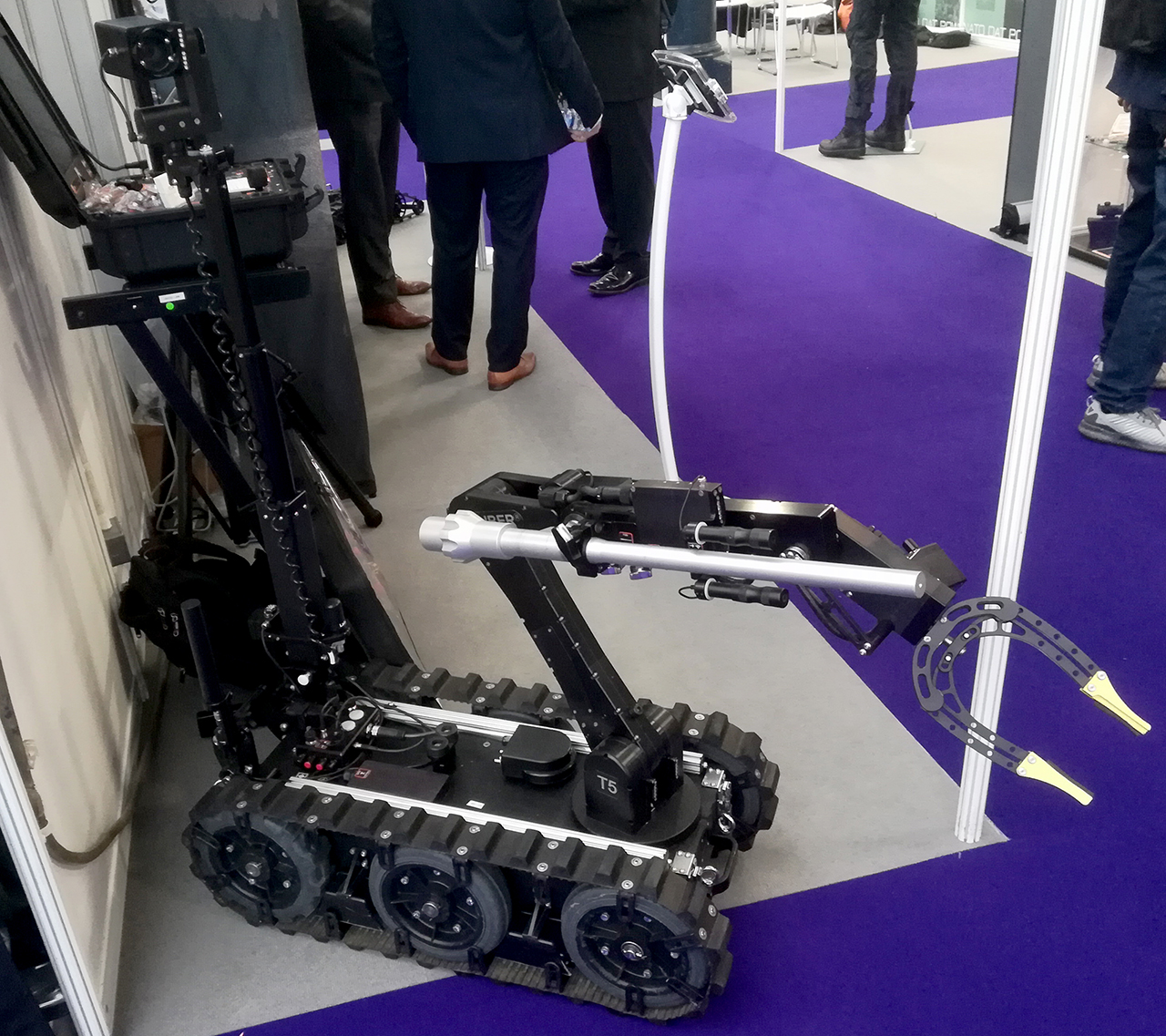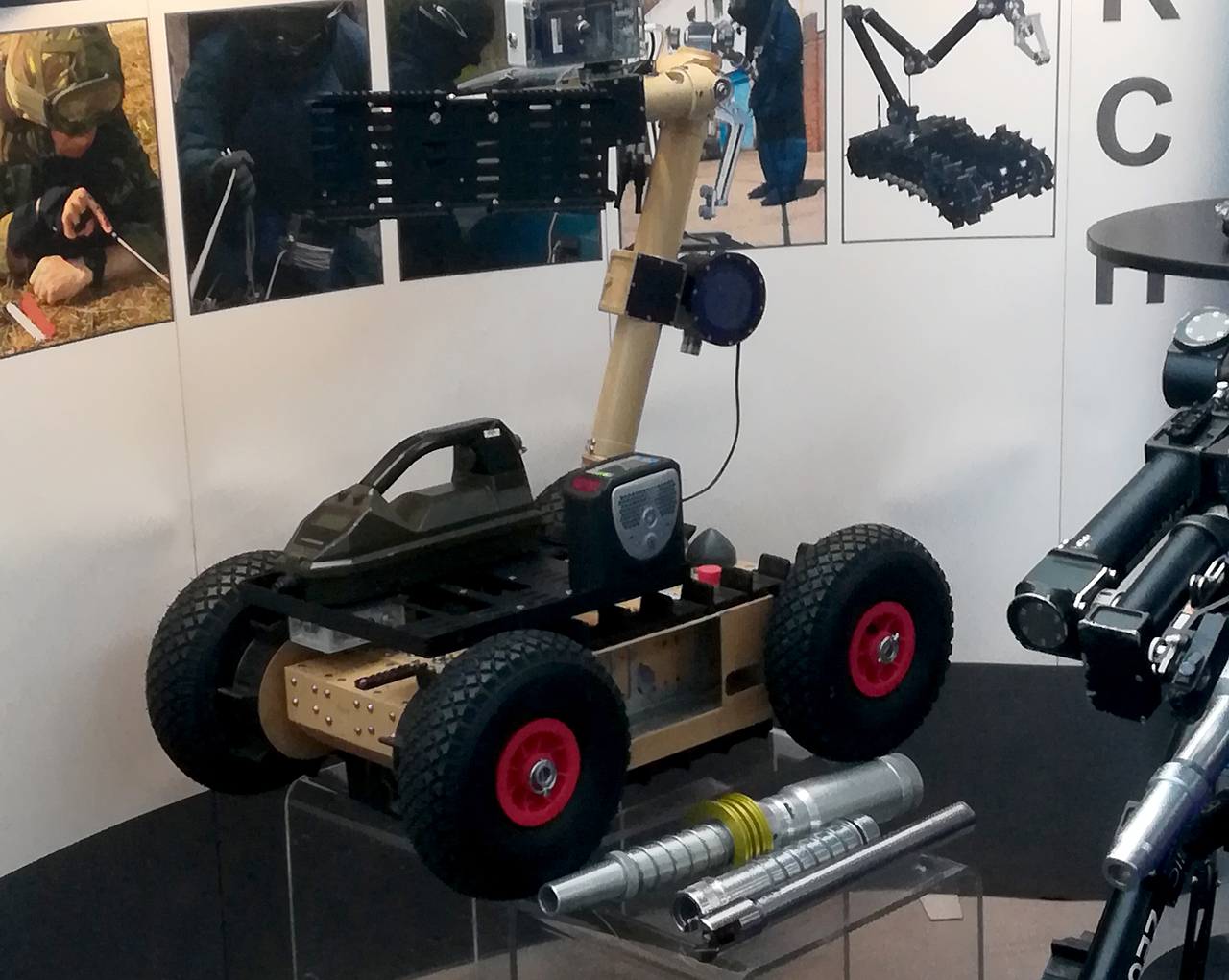event
SCTX2019:
challenges and innovation in counter-terror technology
This year’s Security and Counter Terror Expo (SCTX 2019) focused on defence and security issues across eight diverse fields. From virtual reality military training suites to counter-drone technology,Talal Husseini reviews the key challenges and solutions discussed at the event.

Fortem’s DroneHunter. Image: Fortem
How can virtual reality help to prepare soldiers for battle? How do we protect our airspace from malicious drones? What role can autonomous robots play in military surveillance and threat disposal activities?
These were just some of the themes coming out of this year’s Security and Counter Terror Expo (SCTX 2019). Along with the exhibitors, defence experts from the world’s leading security organisations engaged with the public on what they expect the future of defence technology will look like and how we can improve security capabilities today to prevent a whole new host of future threats, using the latest digital tools, such as automation, AI and virtual reality.
Securing airspace from malicious UAV attacks
Unsurprisingly perhaps, the hot topic of this year’s SCTX 2019 was developing an all-inclusive response to immobilising unmanned aerial vehicles (UAVs), such as the ones that caused serious disruption at Gatwick and Heathrow airports in the UK around the turn of the year.
A host of exhibitors and security officials sought to address the complex drone issue, with different companies offering to provide both hard-kill and soft-kill countermeasures, including Fortem’s autonomous DroneHunter UAV and Aaronia AARTOS all-in-one drone detection suite.
Andrew McQuillan, director of Crowded Space Drones, said: “The government has now given every airport a guarantee that they can get resources there within four hours to detect drones and deal with illegal drones.”
“Nothing out there as it stands today can give you 100% guarantee it will be able to detect any type of drone coming into your airspace or over your event.”
However, McQuillan noted that there are currently no products that can offer a complete system that can detect and stop malicious attacks from all type of UAVs.
“[There are] companies coming in with drone detection products that are claiming they can deal with, for example, the Heathrow and Gatwick incidents and also detect any type of drone coming in,” McQuillan added.
“The problem is that there isn't really a solution out there that can do that. All the big airports right now are looking at a combination of solutions and different types of technology to comprehensively cover it. But nothing out there as it stands today can give you 100% guarantee it will be able to detect any type of drone coming into your airspace or over your event.”
small arms training with virtual reality
Positioned in the middle of the exhibition hall, UK engineering firm Meggitt gave visitors the opportunity to look inside and test the firearms training system (FATS) 180LE – a 180° immersive virtual reality cube for small firearms training.
Inside the FATS facility, three large borderless screens simulated a variety of real-life situations in high definition, giving warfighters the ability to heighten their reactions to threats and increase shooting accuracy.
Meggitt global marketing director for training systems Michelle Henderson said: “The FATS 180LE from Meggitt Training Systems represents the next generation in small-arms training for law enforcement and other security forces.
“The system provides 180° high-definition projection on three borderless 150” X 84” screens with a 16:9 aspect ratio for an immersive experience. A 5.1 surround sound audio system with directional sound effects allows instructors to incorporate unsettling noise from any direction to elevate situational awareness.”
“Inside the FATS facility, three large borderless screens simulated a variety of real-life situations in high definition.”
The FATS 180LE supports up to 20 different simulated weapons, including pistols, rifles, shotguns, as well as less-lethal weapons, such as pepper spray and the TASER weapon. Soldiers using the FATS centre can also train in complete darkness using weapon-mounted flashlights to mimic night situations.
At the show, Meggitt’s exhibitors demonstrated the FATS’s Marksmanship mode, which allows soldiers to train in 3D indoor and outdoor ranges to improve both close and long-range shooting, and improve reactions against simulated enemies who could turn, pop-up and move around.
Currently, the FATS facility is being used to train soldiers in the US Army, US Marine Corps and US Air Force, as well as the UK MOD, the Australian Defence Force, the Canadian Armed Forces and Air Force, and the Singapore Army.
Introducing the autonomous DroneHunter
Tackling threats from drones was one of the key discussion points at SCTX 2019. While many companies claimed to offer drone detection and jamming software, one of the key issues that Fortem CEO Timothy Bean noted was how to stop a drone that cannot be detected through RF signal, as it is not difficult to fly a UAV on waypoints using a tablet and mapping software.
To this end, Fortem created the DroneHunter. The DroneHunter is a fully autonomous UAV that deploys itself as soon as a drone is detected by radar technology, which incorporates hundreds of small radars that build a digitised 3D map of a certain airspace, and shoots a net to capture the enemy drone. Within the 3D airspace, radars create geo-fences that notify the operator when a drone flies out of its corridor and into the restricted airspace.
“There's a radar on the DroneHunter that will lock onto that drone and dogfight it and it will shoot it down.”
“If something enters that geo-fence you have a rules engine, you can cue the police, you can send a text message to security officials around your perimeter, you can cue a camera, you can have a guy running out with his jamming gun, not effective, but you could,” Bean said.
“One thing you can do is you cue a DroneHunter that is in a hangar on top of a building and what it will do is it will get the message autonomously within half a second and it will take off 30m/s – like a bullet – out of its hangar. It will go to where that drone is autonomously, no human flying it. There's a radar on the DroneHunter that will lock onto that drone and dogfight it and it will shoot it down, on the move in the wind and tether it and tow it away.”

Demo of Fortem’s DroneHunter. Video: Fortem
The DroneHunter has the option to be semi-autonomous and can be instructed to launch, pursue, come home, or fire its net. But, according to Bean, no human pilot could take out a drone if it breaks the geo-fence. Fortem tested this with specialists from the US Army and their record of catching drones after 38 attempts was zero.
Bean conceded that the since the DroneHunter only has two shots, it is more of a challenge to deal with swarms of drones. However, Fortem successfully completed a four-on-four scenario where the drones arranged themselves autonomously, and a stadium or city can have multiple DroneHunters at the ready in any given scenario.
The latest EOD robots
There was a large variety of explosive ordnance disposal (EOD) robots on display at SCTX 2019, including ICOR Technology’s CALIBER range and NIC Instruments’ ZEUS range.
ICOR Technology showcased EOD robots ranging from its 333kg Mk4 large EOD robot that can lift up to 200lbs and uses a 9ft vertical camera, six additional cameras, along with weapons and claw sensors to detect and dispose of threats safely.
The smallest of the ICOR range – the Mini-CALIBER SWAT robot is a 29kg portable robot that can be quickly deployed to perform search duties in rooms, stairwells, in confined spaces, and under/inside vehicles. Not only does it have 53” reach using its electronic arm, but it also has two-way audio for tasks, such as crisis negotiation.

ICOR Technology’s ICOR CALIBER T5 EOD robot.
Meanwhile, NIC Instruments demonstrated its ZEUS Ultimate Modular Robot. The Zeus is an all-inclusive UGV used for several activities such as surveillance, communication, reach and dexterity capabilities, as well as EOD with its barrelled disruptors.
One of the unique features of ZEUS is its back blast cylinder that highlights the path of the discharged effluent from the rear of the disrupter, allowing operators to understand whether the discharge is a direct threat to ZEUS or soldiers in the surrounding area.

A Zeus EOD robot from NIC Instruments.
Demo Zone: robot obstacle course and explosive detection dogs
As well as panel discussions and the latest technology on offer, some exhibitors demonstrated their products or services at the Defence Security Demo Zone.
Highlights include a robot obstacle course conducted by Nexter Robotics, which supplies robots to the French Armed Forces and other armies for reconnaissance, anti-IED automated conveying and soldier protection. During the demo, Nexter’s NERVA LG UGV sped around the demo zone floor on both sand and pebbled terrain without issue and, after a three second moderation to incorporate the tracks, was able to climb a set of steps made from crates.
Explosive detection dogs from RFA Security Services and VWK9 also demonstrated how they dealt with a suspicious package with little provocation from the handler. VWK9 also explained the key difference between bomb dogs and people screening dogs, and visitors had a chance to meet the dogs after the demonstration.

Demonstration of Nexter’s NERVA LG robot. Video: Nexter